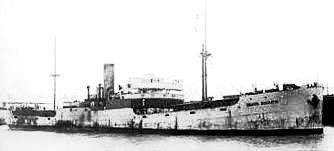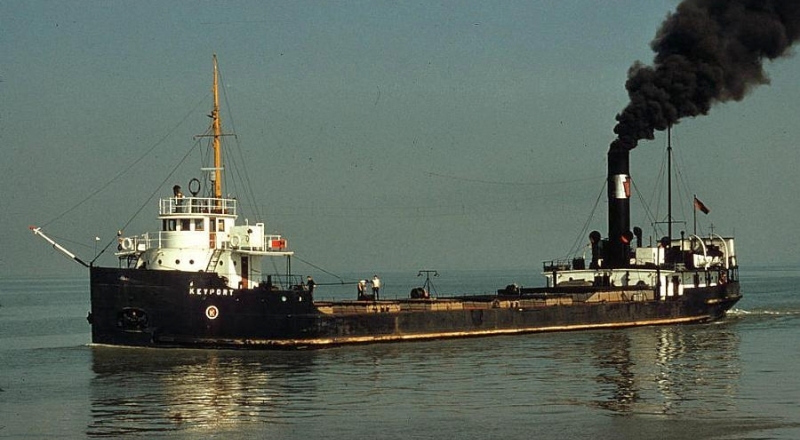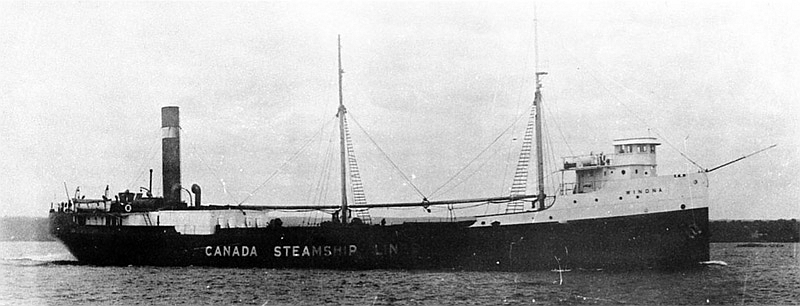 |
| MV Ryholm sitting on the bottom. |
In 1952, the then brand-new
M.V. Ryholm was rammed on the St. Lawrence, creating a 48' hole in her forward hold on the port side. To what must have been the great annoyance of her owners (and their insurance company), she then proceeded to do what many other ships have done in similar circumstances - she sank to the bottom. Fortunately, the bottom wasn't that far away, her wreck was eminently salvageable, and (after an unsuccessful first attempt),
Foundation Maritime managed to
recover the ship and her cargo. The Foundation Maritime team included Robert M. C. (Cornelius) Campbell, who worked for them as a diver from 1930 until 1954.
A native of Purcell's Cove, Nova Scotia, Mr. Campbell went to sea in 1920 or so, and as early as 1922 was ranging as far away as Australia in the S.S.
Canadian Planter.
 |
Two pages from Robert Campbell's Certificate of Discharge book, showing that he found work between 1922 and 1926 on the steam ships Canadian Planter, Canadian Constructor (twice), Canadian Runner, and Canadian Rancher. The book shows that Robert held the rating of Able Seaman (AB).
|
According to
Merchant Ships Built in Canada in World War One by Tim Colton, the S.S.
Canadian Planter was a single-screw steel steamer of 5,399 gross tons built in Montreal by Canadian Vickers in 1920. Interestingly, in my search, I found a
1926 UK Board of Trade Wreck Report referencing a
Canadian Planter, also of 5,399 gross tons (so I have to assume it was the same ship) and a crew of 42, that ran aground near the Matane Buoy on the St. Lawrence River. She was on her way from Vancouver to Montreal at the time.
Canadian Planter survived her grounding, and was renamed
Boka in 1936, but she didn't survive the Second World War - she was torpedoed and lost in 1940. The other ships listed on this page are also mentioned on the Tim Colton website:
- S.S. Canadian Runner, of 3,091 tons, built in Port Arthur, ON, in 1920;
- S.S. Canadian Constructor, of 7,178 tons, built at Halifax Shipyard in 1921;
- S.S. Canadian Rancher, of 3,551 tons, built in Trois Rivieres in 1920.
Two of these ships were Second World War casualties:
Canadian Runner (as
Kari Go) was bombed in 1945, and
Canadian Rancher (as
Widestone) was torpedoed and sunk in 1942.
Canadian Constructor survived until 1947, when she apparently burned.
All of these ships were built for, and initially operated by, the
Canadian Government Merchant Marine (CGMM).
Wikipedia defines an
Able Seaman as "...a Naval rating of the deck department of a merchant ship with more than two years' experience at sea and considered "well acquainted with his duty"." The two-year requirement suggests that Mr. Campbell went to sea in 1920, when he was 17 or so. Wikipedia goes on to add that Able Seaman may "...generally serve as a ship's helmsmen, relying on visual references, compasses, and a rudder angle indicator to steer a steady course as directed by the mate or other officer on the bridge." Included amongst Mr. Campbell's papers that were sent to me are several pages of navigation logs, consistent with him filling the role of helmsman.
 |
| This page seems to cover a portion of the St. Lawrence River near Brockville, Ontario. |
 |
| Downstream of Cornwall, Ontario. |
 |
| This page seem to cover the portion of the St. Lawrence River just downstream of Cornwall, Ontario. |
 |
| I suspect that "Clayton Bluff" and "Carleton Bluff" refer to Carleton and Clayton Islands on the St. Lawrence River adjacent to Gananoque, ON, and just downstream of Lake Ontario. |
 |
| A stretch of the St. Lawrence River between Brockville and Prescott, Ontario. |
In 1924, Mr. Campbell served as a wheelsman for two months (he joined her in Kingston, ON, in April and was discharged in Montreal in June) in the S.S.
Keyport, a ship belonging to
Keystone Transports Limited of Montreal. Built in 1909 on the Tyne,
Keyport was a small steamer of 1,721 gross tons. She worked until 1961, and was broken up in 1963.
 |
| Mr. Campbell's discharge papers from the S.S. Keyport. |
After the Keyport, he moved to sistership
Keybell. The 1,730 gross ton S.S.
Keybell was the only Canadian-built ship in the Keystone fleet - she was constructed at
Collingwood Shipbuilding in 1912. I could not find a picture of her.
 |
| Discharge papers from the S.S. Keybell. |
In 1925, he headed for Australia in the S.S.
Canadian Spinner from February to July.
Canadian Spinner, of 5,758 GRT, was completed in December 1919 and served under that name until 1933. Like
Canadian Planter, she was torpedoed and lost in 1944. She is listed as being 413 feet long, and fitted with a 3-cylinder triple expansion engine and 3 boilers producing 520 n.h.p.
 |
| S.S. Canadian Spinner , shown here as S.S. Onassi Pinelopi for A.S. Onassis, ended up under the Japanese flag as Fukuju Maru, and she was torpedoed by the US Navy during the Second World War. Photo linked in from www.combinedfleet.com and their history of this ship. |
 |
| Discharge paper from the S.S. Canadian Spinner. |
In early 1929, Mr. Campbell was employed on the S.S.
Anticosti from April to July. There was an
S.S. Glenclova built in 1921 at the Midland Shipbuilding Company, and in 1926 she was taken up by Canada Steamship Lines (CSL) and renamed
Anticosti. I'm assuming it was the same vessel. She seems to have survived to the end of 1968, as
Elizabeth Hindman, when she was finally laid up for good.
Later in 1929, Mr. Campbell served four months as a "wheelsman" in the S.S.
Superior. While I can find
a steel package freighter built in Ecorse, Michigan, in 1905 by that name, she wa
s renamed Ralph Budd in 1926, and must be a different ship.
 |
| Discharge paper from the S.S. Superior. |
 |
| A letter of recommendation from the Master of the S.S. Superior, James MacMillan. |
In 1930, Mr. Campbell served six months (first from April to June, and then from August to December) as the 2nd Mate in the S.S.
Winona,
a canal steamer of 2,085 GRT, built at Wallsend-on-Tyne in 1906.
 |
| Mr. Campbell's first stint on the S.S. Winona in 1930. Interestingly, the 1st mate of the Winona appears to be the same J.C. MacMillan who was the master of the S.S. Superior in 1929. |
 |
| Mr. Campbell's discharge papers from his second stint in the S.S. Winona. |
In the early 1930s, Mr. Campbell joined Foundation Maritime's salvage ship,
Foundation Jupiter.
 |
| Mr. Campbell's discharge papers from Foundation Jupiter. |
 |
| Mr. Campbell's reference letter from his time on the Foundation Jupiter. The header of this letter indicates that in 1931, the Foundation Maritime fleet consisted of only two vessels: Foundation Franklin and Foundation Jupiter. |
 |
| Foundation Jupiter. |
Foundation Jupiter was a purpose built derrick vessel, and one of the first ships in the Foundation Company of Canada construction fleet, some of which later became the fleet of subsidiary Foundation Maritime. In
Grey Seas Under (1958), Farley Mowat describes her as "half construction engine - and half ship" and further describes her interesting handling characteristics in great detail. Foundation Maritime went on to acquire a significant fleet of tugs and salvage vessels, of which more information can be found on the
Haze Gray and Underway website.
Sometime after starting work for Foundation Maritime, he appears to have changed careers, and became a diver. In 1934, Mr. Campbell was involved in installing water intakes for St. Lawrence Paper.
 |
| This photo is captioned "St. Lawrence Paper intake valve 1934". |
 |
| Mr. Campbell working on the St. Lawrence Paper intake. The diving platform looks rather....basic. |
 |
| Envelope for a 1940 reference letter. |
 |
| 1940 reference letter for Mr. Campbell from the Foundation Company of Canada, parent company of Foundation Maritime. |
 |
| Reference letter from K.E. Garlick of John Date Ltd. (a supplier of commercial diving equipment) in Montreal. The history of this firm is a story in itself. |
In 1943, Mr. Campbell (with Foundation Maritime) was involved in the salvage of the S.S
Trongate, a British ship laden with munitions and war material. There is a good description of the events around her sinking in Graham Metson's "
An East Coast Port...Halifax at War 1939-1945" on pages 104-106. On the evening of April 9, 1942, while anchored off the ferry slip,
Trongate reported a fire below decks, and Halifax's fire boat
Rouille and Foundation Maritime's tug
W.J. Hanrahan responded, and eventually HMCS CHEDABUCTO was ordered to stand by and sink
Trongate with gunfire if necessary. The Naval authorities decided that it wasn't worth the risk of fighting the fire, and ordered CHEDABUCTO to sink
Trongate with practice shells, which they did at 0325 on April 10. As CHEDABUCTO prepared to sink the
Trongate, the
W.J. Hanrahan apparently made it to shore before realizing that they had left one of their engineers (a Ron Inness) aboard, and she had to return to the ship to take him off.
Trongate's wreck still contained her cargo of munitions and other war materials, and the salvage appears to have continued on and off for several years.
 |
| This photo from the Campbell collection, labelled "Salvage Cargo S/S Trongate 1943", shows what appears to be some sort of tracked vehicle being recovered from the Trongate wreck in the depths of Halifax Harbour, with the Dartmouth shore in the background. Trongate's cargo and location in the main harbour must have been particularly worrisome to the Naval authorities while they considered their course of action to fight the fire, and their decision instead to scuttle her. I am assuming that Mr. Campbell is the diver in the photo. |
In 1944, Mr. Campbell was involved in the salvage of the S.S. Beaverhill, a ship that became a total loss after running around in Saint John, NB. I have a significant collection of photos of the wreck and subsequent salvage, which will have to wait until another blog post.
 |
| Mr. Campbell around the time of the Beaverhill salvage. |
 |
| Instructions for using a preheater. |
 |
| Some journal entries detailing some of the more mundane activities of a diver working for the Foundation Company of Canada, which involved not just marine salvage work, but construction work as well - although there is a reference here to what I assume to be the Foundation Franklin, the legendary tug of Farley's Mowat's Grey Seas Under fame. |
 |
| More journal notes detailing work for the Foundation Company of Canada. |
 |
| Mr. Campbell's records of diving on the wreck of the S.S. Clare Lilley. |
The
S.S. Clare Lilley was wrecked in Portuguese Cove on Halifax Harbour on 17 March 1942, with a cargo of munitions and other war supplies. Although Foundation Maritime evidently dived on her in 1951, the
Maritime Museum of the Atlantic website indicates that Canadian Navy divers removed additional munitions in the 1970s, and that more munitions remain at the wreck site.
 |
| I have so far been unable to find a wreck in Canadian waters called the Odessa. |
 |
| The cover of Mr. Campbell's union card. |
 |
| The inside cover of Mr. Campbell's union booklet. |
 |
| Inside the union booklet. |
All of which brings us back to M.V. Ryholm: she was a small Swedish freighter (1,733 tons) built in 1951 for Sweden America Lines. In 1952, while carrying a cargo of cars, she was rammed on her port side ahead of the bridge (cutting a gaping hole about 48' in length) and she sank on an even keel in 30 feet of water (at low tide) on the St. Lawrence River, about 31 miles below the city of Quebec. This location is subject to tides of between 19 and 23 feet, and she alternated between having only the top of her superstructure and her decks visible. This gave the salvors between 1 and 3 hours per day when work was possible. Apparently the first attempt to salvage her was unsuccessful, with the failure of a wooden patch built to cover the gaping hole in her side. She therefore had to wait until the next spring, in 1953, before being refloated; the wood patch was replaced with a more robust steel patch at that time. She was refloated on June 6, 1953, and was delivered to a drydock for repairs on June 20. Ice in the river seems to have scraped much of her paint off during the winter. After being salvaged, she was repaired and returned to service. It was within my writeup of the salvage operation on the Haze Gray and Underway website that his granddaughter found the following photos of Mr. Campbell in his diving suit. Mr. Campbell would have been needed to help place the steel patch over the gaping hole in the side of the ship.
 |
| Robert Campbell working the Ryholm wreck, with the bow of the tug Foundation Frances in the background. |
 |
| Robert Campbell working the Ryholm wreck. |
 |
| A photo of Mr. Campbell, probably taken around the time of the M.V. Ryholm salvage. |
|
|
An undated photo of Robert Campbell in his diving gear.
|
The work was not easy, and in more ways than one - though he may have retired from diving as early as 1954, he remained with Foundation - in a 1958 letter to his wife from a job in Ottawa, he indicates that the level of pay reminds him of a job during the Depression, and he hopes that his wife and children are not starving to death. He also indicated a desire to find work closer to home.
 |
| Robert and Rita Campbell. |
Mr. Campbell retired from the Foundation Company of Canada after 33 years (probably around 1964), and passed away in 1975.
Acknowledgements:
This is probably my most involved blog post yet, and resulted from having a large number of photos and documents dumped into my lap.
Many thanks to Dawn Hendsbee for taking the time to copy and send me the papers and photos that make up the majority of this post. Dawn is in the process of trying to locate a diving helmet used by her grandfather.
Where Mr. Campbell spent much of his time in the Great Lakes and on the St. Lawrence Seaway, I have found the Maritime History of the Great Lakes website to be most useful in tracking down many of the various vessels that he served in. Various other links within this post will take you to other external websites where I found background information on the various ships and documents listed within. Some of the Foundation Maritime photos and information come from my own collection, sourced over the years primarily from old Foundation Company of Canada files in the Halifax and Toronto archives of AECON.
















































